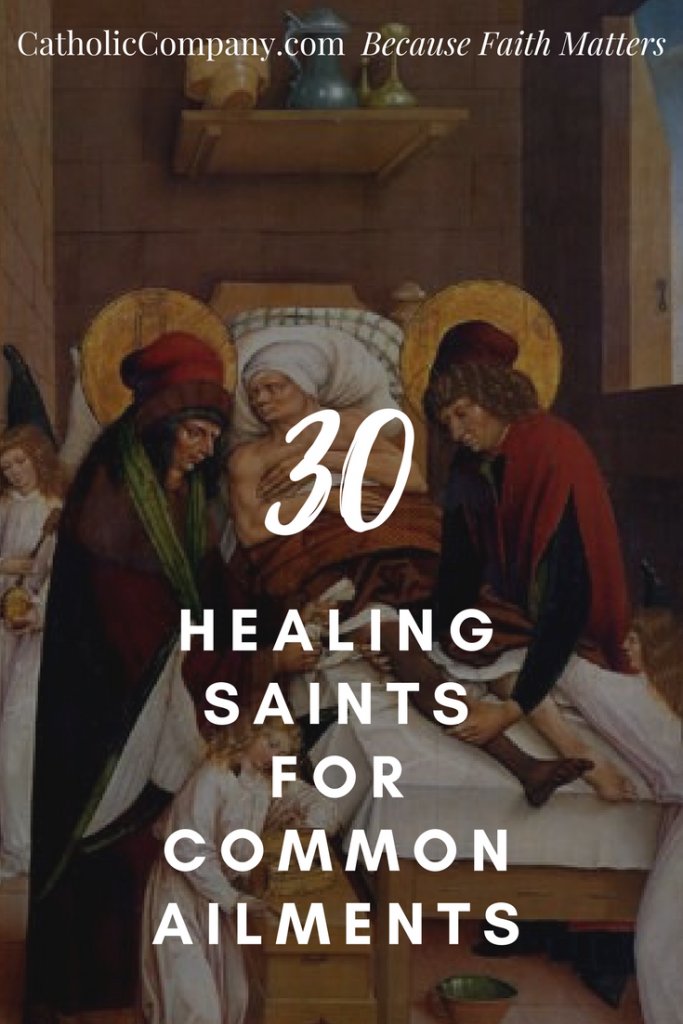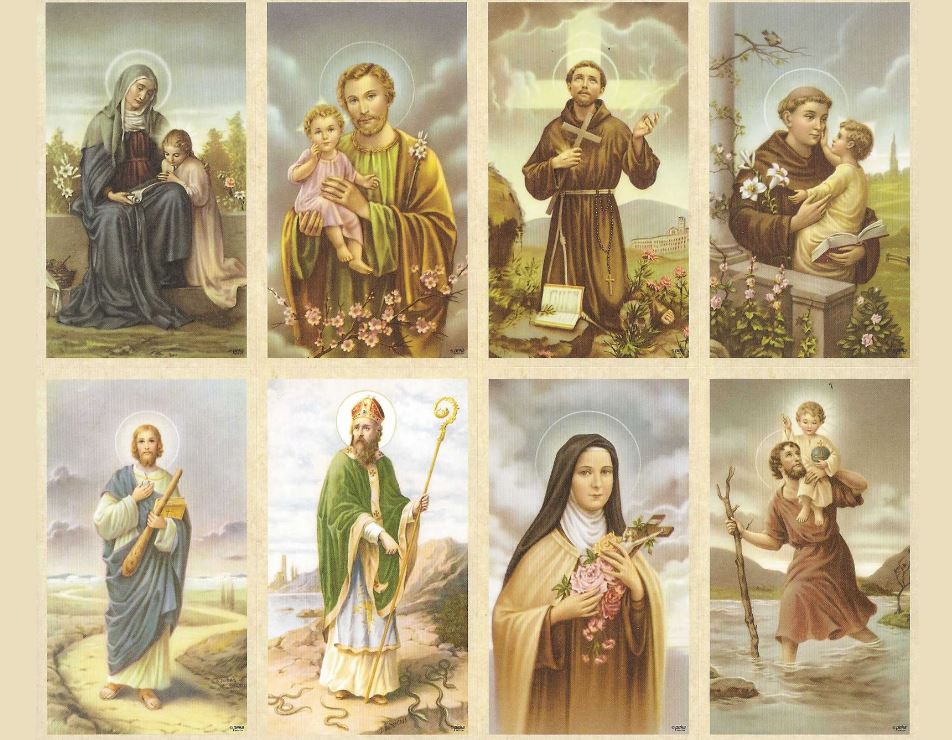
A Catholic List of Saints and What They Protect
Most Catholics have a patron saint that they look up to, or one who inspires them. Saints often become associated with certain ailments or activities due to how they lived their lives or interceded for others.
There are many different patron saints for countries, cities, organizations and more. Some saints seem like they always led virtuous lives, but many went through hardships and struggles to grow closer to God.
St. Thomas Aquinas
St. Thomas Aquinas was an Italian Roman Catholic theologian (religious scholar) who worked to reconcile human reason and Christian faith. His writings, which combined Aristotle’s ideas with traditional church doctrine, became the basis for official Roman Catholic teaching (known as Thomism). Aquinas’ forward-looking political views regarding natural law, unjust rulers, and rebellion influenced European Enlightenment philosophers such as John Locke, and American revolutionaries including Thomas Jefferson and Martin Luther King.
Aquinas was born into a family of noble rank in 1225. At the age of five, his family sent him to a Benedictine monastery in Monte Casino to be educated as a monk. He excelled, surpassing his teachers in both learning and virtue. His exemplary character and theological insights earned him widespread approbation. He entered the Dominican Order at the age of 18, a choice that dismayed his family.
In 1245, Aquinas traveled to Paris and studied under Albert the Great, who had a masterful grasp of both Greek and Arabic philosophy. Aquinas embraced Albert’s program of melding Christian theology with Greek and Arab philosophy, which later evolved into his “Summa Theologiae.”
One of the major issues in his philosophy is divine law. Aquinas defines divine law as the law of God revealed to humans through scripture and the life and teachings of Jesus Christ. He divides this law into two categories, the Old Law and the New Law, which correspond to the Old Testament and New Testament of the Bible. The New Law consists of the commandments and teachings of Jesus Christ.
Aquinas also explains the nature of virtue. He describes the virtues of prudence, justice, temperance, and courage, as well as the intellectual virtues of knowledge, faith, and hope. He distinguishes between general types of rectitude, which are characterized by various specifications and specific acts of rectitude, and the cardinal virtues, which are the principle habits on which the other virtues depend (cardo) for their fullness.
There have been many anti-Scholastics who hold that Scholasticism is superfluous and confusing, but those who understand the “Summa” will recognize that St. Thomas demonstrates admirably the ways that the Holy Spirit leads souls toward salvation. He also explains the gifts and fruits of the Holy Spirit in the prologue to the “Summa” and in his commentary on Dante’s “Divina Commedia.”
St. Christopher
Saints are people from the past who Catholics can look to for inspiration and encouragement. They are champions of the faith, and their exemplary lives help us to better understand Jesus Christ. Many of them suffered terrible martyrdoms and performed miracles, so it’s not surprising that they are considered to be protectors. They can protect us from evil and even from disease, accidents, or natural disasters.
The list of Catholic Saints is vast, and each one has its own unique story to tell. Some are known for their intellectual gifts, while others have become famous for their virtuous lifestyles and acts of charity. Whether they are known for their miraculous healing powers or their powerful intercession, each of these saints are worthy of our praise and devotion.
St. Christopher, also known as Agios Khristophoros or Hagios Christophoros, is the patron saint of travelers and the protector against lightning. According to legend, he was a large and strong man from the Eastern Mediterranean region who was looking for a powerful master to serve. He decided to join a group of thieves who preyed on travelers until he was stopped by a traveler who made the Sign of the Cross.
From then on, he was converted and is now the patron saint of travelers and the protector against lighting and storms. In addition, he is a beloved saint and is often depicted carrying a child on his shoulders across a river or road. In fact, he is one of the Fourteen Holy Helpers who are a popular group of saints to seek intercession from for specific professions, lands, or actions.
Like the other saints on this list, St. Joseph is also known for protecting travelers and their belongings from harm. He is believed to be a compassionate and kind man who treats everyone with respect and kindness. He is also a patron saint of carpenters and builders, as well as a protector against fires and floods. It is said that he once made peace between a hungry wolf and the town that feared him.
St. Jude
The patron saint of hopeless cases, St. Jude Thaddeus, is known for his powerful intercession and is believed to be able to help people in difficult situations. He is a patron saint for those who feel lost and hopeless, and many prayers have been answered through his intercession.
Little is known about the early life of St. Jude, but he is mentioned in the Bible as one of Jesus’ apostles. He is also called “Thaddeus” or “Judah,” and some scholars believe that he was the brother of another apostle, St. James the Lesser, and that his father was Clopas and his mother, Mary, was a cousin of the Virgin Mary.
After the death and resurrection of Jesus, St. Jude traveled and preached, often in dangerous circumstances. He is believed to have died a martyr’s death, although details vary. Some say he was clubbed to death and others that he was killed with an axe. His relics were brought to Rome, where they are now buried in a crypt at St. Peter’s Basilica.
He is celebrated on October 28th and invoked by Catholics in times of need, especially when all other remedies have failed. He is the patron saint of impossible cases, hospitals and hospital workers, stray animals and lost causes, and is usually depicted holding an image of Jesus or a book, which represents his Epistle.
Despite his powerful intercession, devotion to St. Jude waned over the centuries, and his name became confused with Judas Iscariot, the betrayer of Jesus. However, in the 1930s, a devout Catholic named Danny Thomas decided to pray to him for his livelihood. He promised that if God helped him get his act together, he would build a shrine to St. Jude, where people could seek his intercession and hope when all other solutions had failed. The shrine was built, and devotion to St. Jude quickly spread. His popularity grew even more during the Great Depression and World War II, when so many people were struggling with difficult situations and needed a ray of hope. This is a great time to make a gift in honor or memory of someone special.
St. Francis of Assisi
St. Francis of Assisi (1181/1282-1226) is the patron saint of ecology, animals and nature because he believed all creatures were created as God’s “brothers and sisters.” He reportedly preached to birds and had compassion for lepers and even predators such as wolves. He has also been credited with many miracles, including healing severely sick people and even being able to speak to and commune with animals.
Born Giovanni Francesco di Bernardone, he was the son of a wealthy cloth merchant. As an ambitious young man, he wanted to distinguish himself in military battle so he could receive a rank as a knight. However, after a traumatic experience on the battlefield and a vision in a crumbling church, Francis changed his outlook on life and began to embrace poverty and chastity.
He founded a new monastic order and traveled throughout Italy and Europe, preaching the Gospel. He emphasized simplicity, humility and loving service to others. His spiritual confidant, St. Clare, followed in his footsteps and gave up all her wealth and privilege to live a life of poverty and chastity.
In 1224, Francis was visited by a vision of Christ Crucified that caused him to exhibit stigmata—the real wounds of Jesus, including nails in His hands and feet, punctures from the crown of thorns and an injury on His side from a lance. The Catholic church requires that a person with stigmata be a priest and that the wounds bleed on important religious days, such as Good Friday.
Pope John Paul II officially named St. Francis as the patron saint of ecology and those who promote environmentalism in 1979, through a papal bull. He praised the saint’s respect for nature and its gifts and wrote that “Poverty is an attitude of total dependence on God, which recognizes all things as his gift to us. This gift is not just physical or economic; it also consists of the spirit of the Gospel, which includes the whole universe.”






